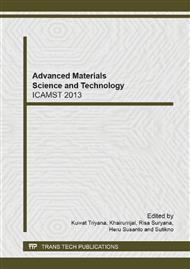[1]
S. Hutagalung, Lowering calcination temperature of CaCu3Ti4O12 formation by modified mechanical alloying process, Emirates Journal for Engineering Research, 12 (2007) 61-64.
Google Scholar
[2]
Z.G. Ban, S.P. Alpay, Optimization of the tunability of barium strontium titanate films via epitaxial stresses, Journal of Applied Physics, 93 (2003) 504-511.
DOI: 10.1063/1.1524310
Google Scholar
[3]
S. Stemmer, S.K. Streiffer, N.D. Browning, C. Basceri, A.I. Kingon, Grain boundaries in barium strontium titanate thin films: Structure, chemistry and influence on electronic properties, Interface Science, 8 (2000) 209-221.
DOI: 10.1023/a:1008794520909
Google Scholar
[4]
C.C. Young, B.S. Lee, Bottom electrode dependence of the properties of BST thin film capacitors, Material Chemistry and Physics, 61 (1999) 124-129.
DOI: 10.1016/s0254-0584(99)00120-0
Google Scholar
[5]
J. R Cheng, L.X. Zhou, D.R. Jin, C.J. Xie, Sintering and Dielectric Properties of Sr-Rich Barium Strontium Titanate (BST) Ceramics Fabricated by a Mixed-Phase Method, Advanced Materials Research, 683 (2013) 94-97.
DOI: 10.4028/www.scientific.net/amr.683.94
Google Scholar
[6]
H. Liu, V. Avrutin, C. Zhu, U. Ozgur, J. Yang, C. Lu, H. Morkoç, Enhanced microwave dielectric tunability of Ba 0. 5 Sr 0. 5 TiO 3 thin films grown with reduced strain on DyScO 3 substrates by three-step technique, Journal of Applied Physics, 113 (2013).
DOI: 10.1063/1.4789008
Google Scholar
[7]
S.S. Massoud, L.L. Quan, K. Gatterer, J.H. Albering, R.C. Fischer, F.A. Mautner, Structural characterization of five-coordinate copper (II), nickel (II), and cobalt (II) thiocyanato complexes derived from bis (2-(3, 5-dimethyl-1-pyrazolyl) ethyl) amine, Polyhedron, 31 (2012).
DOI: 10.1016/j.poly.2011.10.011
Google Scholar
[8]
Z. Sauli, V. Retnasamy, S. Taniselass, A.H. Shapri, R.M. Hatta, M.H. Aziz, Polymer core BGA vertical stress loading analysis, (2012) 148-151.
DOI: 10.1109/cimsim.2012.83
Google Scholar
[9]
I. Irzaman, H.D. Darmasetiawan H.H. Hardhienata, M.H. Hikam, P.A. Arifin, S.J. Jusoh, S.T. Taking, Z.J. Jamal, M.I. Idris, Surface Roughness and Grain Size Characterization of Annealing Temperature Effect For Growth Gallium and Tantalum Doped Ba0. 5Sr0. 5TiO3 Thin Film, Atom Indonesia Journal, 35 (2011).
DOI: 10.17146/aij.2009.48
Google Scholar
[10]
J. Antony, Improving the wire bonding process quality using statistically designed experiments, Microelectronics Journal, 30 (1999) 161-168.
DOI: 10.1016/s0026-2692(98)00104-9
Google Scholar


